Back in 2015, Valve released the Steam Machine. This was a dedicated computer, running a special version of Linux, designed for playing Steam games. Critics praised its performance, as well as the companion Steam controller.
However, the Steam Machine proved unpopular with the public at large. People who wanted a low-cost, dedicated gaming machine already owned consoles. Existing Steam users already owned PCs, and didn’t need to invest in another one just for gaming. As sales lagged, Valve quietly pulled the Steam Machine from the market in 2018.
But new AMD processor technology has allowed for much smaller mini PCs. Valve has taken advantage of that, and developed the Steam Deck, released in February of this year. Instead of building something like a PC, Valve went the other direction, and developed a smaller, handheld console.

The Steam Deck can play any game in the Steam library, and it’s designed to maintain that support for years. The controls, meanwhile, are designed to replicate everything you can do with a mouse and keyboard. The result is a handheld game system with an unparalleled selection of games.
That said, the Steam Deck comes in a few different variants, some of them more affordable than others. If you go for the lowest-cost version, you’ll net yourself some significant savings. But the internal storage on that model is limited to 64GB. Even the one with the most storage only comes with 512GB built-in.
If you have a lot of games in your current rotation, that might not be enough. Fortunately, you can expand your native storage with a micro SD card. The load speeds won’t be as fast as they are from the system’s built-in SSD. This is particularly true if you opted for a Steam Deck with NVMe storage. But you’ll still be able to add more games without deleting anything from your hard drive.
Today, we’re going to review three of the best micro SD cards for use with your Steam Deck. We looked for cards with plenty of capacity, so you’re not wasting your time by adding a tiny amount. We also wanted to find cards with fast read/write speeds, for minimal wait time.
And of course, we wanted cards that were safe and reliable, so your data doesn’t get corrupted. To find out which card is the best, we need to consider these and other aspects of their design. After that, we’ll make a final comparison between the three. Let’s get started!
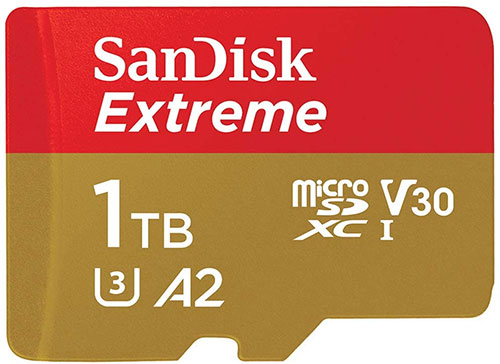
Best Overall: SanDisk Extreme Micro SD Card
If you’ve shopped for any kind of storage technology, you’ve probably heard of SanDisk. They’re known for all kinds of high-quality storage. It only stands to reason that they’d be leaders in the SD card marketplace as well.
The SanDisk Extreme is a two-tone red-and-gold SD card that comes in four sizes. The largest is 1TB, but it can also be ordered in 512GB, 256GB, and 128GB sizes.
Available Capacities: 1TB, 512GB, 256GB, 128GB.
Read Speeds: Up to 160MB/s.
Write Speeds: Up to 90MB/s.
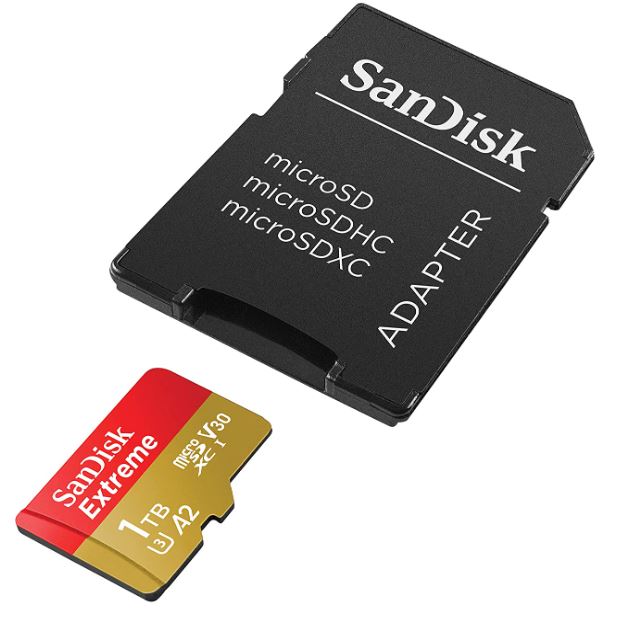
This is an ultra-fast SD card, specifically designed for use in HD video cameras. It can write 4K video in real time, at speeds of up to 90MB/s. At this point, the write speed becomes almost irrelevant. No internet connection is anywhere near that fast, so you’ll still be capped by your internet speed. More to the point, you’ll get read speeds of 160MB/s. That’s still not as fast as the internal SSD, but it’s insanely fast by SD card standards.
As you might have guessed from its name, the Extreme is designed to handle a lot of abuse. To begin with, it’s waterproof. That might not matter when it’s inside your steam deck, but it’s a useful feature under other conditions. The card is impervious to heat and cold. Obviously you wouldn’t put it in the oven, but you can leave it in your car on a hot day. It’s also shock-proof, so it won’t get damaged by a sudden power surge or spike. And X-ray proofing makes it safe to take through airport security.
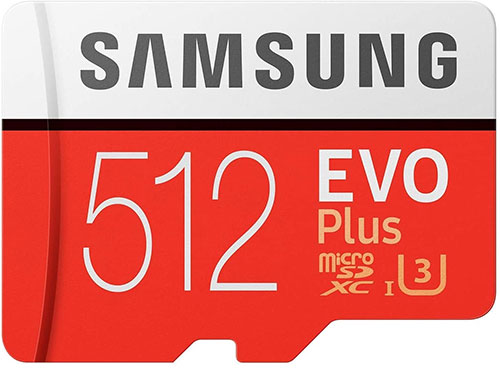
Best Runner-Up: Samsung EVO Plus Micro SD Card
Samsung is one of those brands that needs no introduction. Their electronics are famous for their high quality, and we’ve reviewed several of their products in the past.
The Samsung EVO Plus is a red and white SD card, with a black stripe running down the center. It’s available in three different capacities: 128GB, 256GB, and 512GB. This gives you the ability to double your storage space, even on the highest-capacity Steam Deck.
Available Capacities: 512GB, 256GB, 128GB.
Read Speeds: Up to 100MB/s.
Write Speeds: Up to 90MB/s.
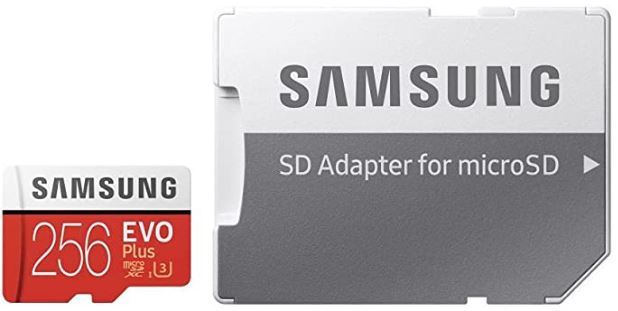
The read speed of 100MB/s isn’t as fast as the SanDisk, but it’s still fairly fast. Depending on your game, you may not even notice a significantly longer load time. Meanwhile a 90MB/s write speed will more than keep up with even the fastest internet connection. Your game downloads will install seamlessly.
This is a very rugged SD card, capable of withstanding a variety of adverse conditions. It has many similar protections to the last SD card we looked at. It’s waterproof, temperature-proof, and even X-ray proof. However, the EVO Plus is also magnet-proof. We wouldn’t recommend waving magnets around your Steam Deck to begin with. But if you’re traveling, you’re not always in control of what your gear is exposed to. As a result, magnet-proofing is a worthwhile feature to have.
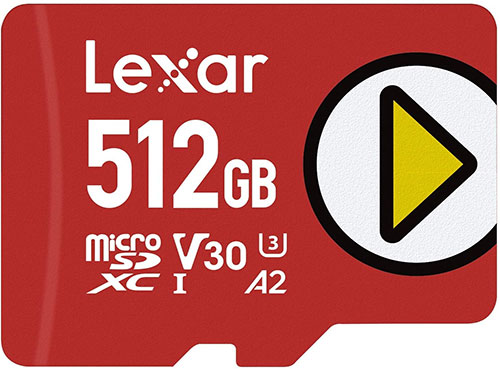
Best Alternative: Lexar PLAY Micro SD Card
Lexar isn’t quite as well-known a brand as the other two, but it’s still well-respected. As it turns out, Lexar makes some pretty high-quality SD cards.
The Lexar PLAY is a bright red SD card, with a white and yellow Play button towards the front. It ships in four different sizes: 128GB, 256GB, 512GB, and 1TB. That’s plenty of options for anybody.
Available Capacities: 1TB, 512GB, 256GB, 128GB.
Read Speeds: Up to 150MB/s.
Write Speeds: Up to 70MB/s.
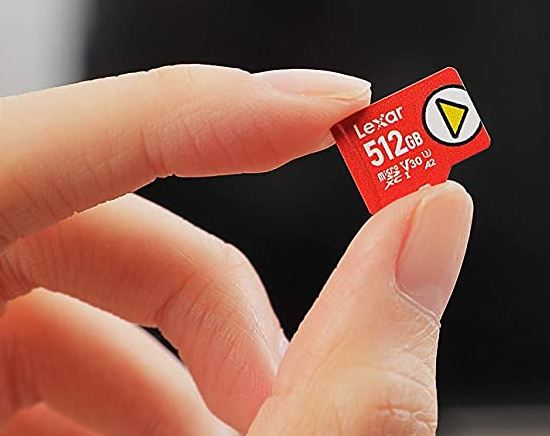
The maximum read speed of 150MB/s is right up there with the fastest on the market. That’s because it’s specifically designed for gaming and video storage. Unfortunately, while the write speed isn’t listed, it seems to top out at around 25MB/s. That’s still plenty for downloading and installing. But if you’re transferring data from your internal drive to the card, it will be noticeably slower.
One thing we should add is that the PLAY offers enhanced reading and writing performance on Android devices. This isn’t relevant to the Steam Deck, of course. But if you want to swap one card between multiple devices, you’ll get solid Android performance. The 128GB and 256GB variants meet the Android A1 standard for SD storage. The 512GB and 1TB variants are even faster, meeting the latest A2 standard.
Choosing the Best Micro SD Card for Steam Deck
Not that long ago, SD cards were a terrible choice for video game storage. Simply put, you didn’t get very good reading and writing speeds. If you were playing a game like Fallout 4, with lots of loading screens, this could become excruciating.
But advances have been driven mainly by demand from the camera industry. Modern 4K, 6K, and 8K videos have incredibly high bitrates, particularly when they’re uncompressed. This requires SD cards that are capable of very high read/write speeds. Otherwise, your SD card would be too slow to record live video.
Keep in mind that these micro SD cards are still not as fast as your Steam Drive’s built-in drive. But a modern SD card in 2022 will far outperform older models.
When looking at the read/write speed, read speed should be your primary concern. You have to load data all the time, and the save files you write are normally very small. The only time write speed becomes a concern is if you’re copying data from your SSD to the SD card.

Classifications
SD cards come in different classifications, such as regular SD, SDHC, and UHS. We strongly recommend using UHS cards, for a couple of reasons. For one thing, they can support the fastest read/write speeds. For another thing, UHS cards support the exFAT format.
This is a more advanced removable storage format that can be used to store larger files. It’s essential for installing many of the games in Steam’s library. You should ignore ratings like A1 and A2. These are Android-specific ratings, and they have nothing to do with the Steam Deck. Then again, if you want to use the same card for Android devices, an A1 or A2 rating may be relevant.
Capacity
The last and most obvious thing to think about is the drive’s capacity. Most drives come in different sizes, with larger sizes costing more. In most cases, it makes the most sense to invest in the smallest size you don’t think you’ll fill up.
For example, if you think you might need 300GB of storage, it makes sense to invest in a bigger drive. If your drive is available in 256GB, 512GB, and 1TB, the 512GB option would make the most sense.
Best Steam Deck SD Card?
So, which of these cards is the best choice for your Steam Deck? Let’s recap what we’ve talked about.
The SanDisk Extreme has the fastest read capacity, at up to 160MB/s. At least in theory, this should get you the fastest loading times. As an added bonus, it has a number of protective features, such as shock-proofing and waterproofing. And with many capacities to choose from, there’s a good choice for any budget.
The Samsung EVO Plus has the most safety protections of all today’s choices. There’s no 1TB size available, but 512GB should be big enough for almost anybody. The read speed is slower than the other two, although 100MB/s is still pretty fast. The slower write speed is a non-issue, for reasons we already discussed.
The Lexar PLAY supports read speeds of 150MB/s, which is almost as fast as the SanDisk. The slower write speeds are actually a drawback here, if you frequently move your game files from drive to card. Then again, you get excellent performance on Android devices. This can be very useful if you want to use the card for both your Steam Deck and your phone.
Meet Ry, “TechGuru,” a 36-year-old technology enthusiast with a deep passion for tech innovations. With extensive experience, he specializes in gaming hardware and software, and has expertise in gadgets, custom PCs, and audio.
Besides writing about tech and reviewing new products, he enjoys traveling, hiking, and photography. Committed to keeping up with the latest industry trends, he aims to guide readers in making informed tech decisions.

